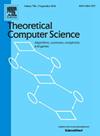Efficient algorithm for stochastic rumor blocking problem in social networks during safety accident period
IF 0.9
4区 计算机科学
Q3 COMPUTER SCIENCE, THEORY & METHODS
引用次数: 0
Abstract
Rumor sources spread negative information throughout the network, which may cause unbelievable results in real society especially for social safety field. Propagating positive information from several “protector” users is an effective method for rumor blocking once the rumor is detected. Based on the probability of each user being a rumor, “protector” nodes need to be selected in order to prepare for rumor blocking. Given a social network , where is the probability that v is activated by u after u is activated, and Q is the weight function on node set V, is the probability that v will be a rumor source. Stochastic Rumor Blocking (SRB) problem is to select k nodes as “protector” such that the expected eventually influenced users by rumor is minimized. SRB will be proved to be NP-hard and the objective function is supermodular. We present a Compound Reverse Influence Set sampling method for estimation of the objective value which can be represented as a compound set function. A randomized greedy algorithm with theoretical analysis will be presented and other two different “protector” selection strategies will be proposed for comparison. Finally, we evaluate our algorithm on real world data sets and do comparison among different strategies.
安全事故期间社交网络中随机谣言屏蔽问题的高效算法
谣言源会在整个网络中传播负面信息,这可能会在现实社会中造成令人难以置信的结果,尤其是在社会安全领域。一旦发现谣言,由多个 "保护者 "用户传播正面信息是一种有效的谣言阻断方法。根据每个用户成为谣言的概率,需要选择 "保护者 "节点,为谣言阻断做准备。给定一个社交网络 G=(V,E,P,Q),其中 P(u,v) 是 u 激活后 v 被 u 激活的概率,Q 是节点集 V 的权重函数,Qv 是 v 成为谣言源的概率。随机谣言阻断(SRB)问题是选择 k 个节点作为 "保护者",使最终受谣言影响的用户数量最小。SRB 将被证明是 NP 难问题,而且目标函数是超模的。我们提出了一种用于估计目标值的复合反向影响集抽样方法,该方法可以表示为一个复合集函数。此外,我们还将介绍一种带有理论分析的随机贪婪算法,并提出其他两种不同的 "保护者 "选择策略进行比较。最后,我们将在实际数据集上评估我们的算法,并对不同的策略进行比较。
本文章由计算机程序翻译,如有差异,请以英文原文为准。
求助全文
约1分钟内获得全文
求助全文
来源期刊

Theoretical Computer Science
工程技术-计算机:理论方法
CiteScore
2.60
自引率
18.20%
发文量
471
审稿时长
12.6 months
期刊介绍:
Theoretical Computer Science is mathematical and abstract in spirit, but it derives its motivation from practical and everyday computation. Its aim is to understand the nature of computation and, as a consequence of this understanding, provide more efficient methodologies. All papers introducing or studying mathematical, logic and formal concepts and methods are welcome, provided that their motivation is clearly drawn from the field of computing.
 求助内容:
求助内容: 应助结果提醒方式:
应助结果提醒方式:


